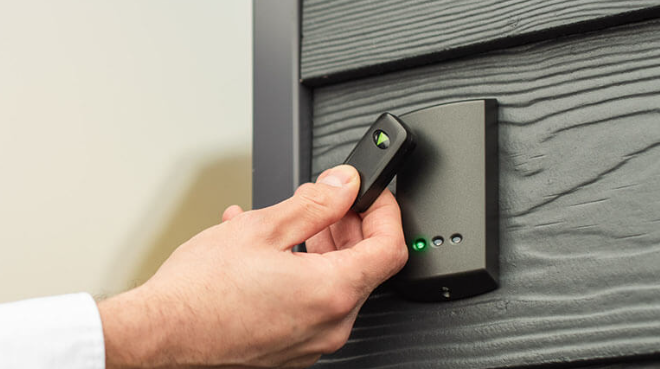Warehouse Access Control: Should You Go For Keycards Or Fobs?

When running an important industrial business like a warehouse, security is paramount. It’s great if you feel like you can trust your staff. However, accidents happen. People find themselves lost, especially new starters in your business. Loss of stock and shrinkage are valid concerns, too.
These are not problems that you should brush off or ignore; they are real, genuine issues. As such, many warehouses are turning to an expert locksmith to help them fit access control terminals.
What Are Access Control Systems
Access control devices are the ideal solution for any business looking to upgrade its security. When in place, access control systems provide a great way to manage and authenticate access to your building or parts of your building.
Hierarchical management means you can ensure only certain staff can enter specific parts of the building, making it easier to manage, restrict, and control access to every part of your warehouse. Generally, you have two access options: keycards and fob devices.
Both are highly popular and provide you with a range of options to pick from. Naturally, a keycard is the most standard choice; pop the card next to the access control device, like you would your debit card to a contactless payment device.
With the use of Near Field Radio Technology, the scanner then verifies the card’s credentials, providing or denying access. Fobs work in much the same way, using a small mechanical device to gain access, much like you would most modern cars in the UK.
So, what is right? Both are great choices. However, both have their limits that you need to contend with, too. In this article, we’ll break down both options. Then, you should find it easier to make an informed choice on what is the right selection for your warehouse in.
When fitted by a professional locksmith both keycards and fobs are great choices. Which, though, is right for you?
Keycards and Fobs: The Basics
So, access control is now the de facto best solution for managing and maintaining security in your warehouse. Instead of just relying on good faith or your security staff being able to keep track of everything, access control makes this easier. You can easily track and trace who has entered what part of the building, and when, ensuring more robust, lasting security protocols.
As we mentioned above, keycard and fob access control are reminiscent of what you would use to open most cars today. Think about the little gadget you use to open your car doors. Or, to double-check, you have locked it from the comfort of your doorway. Well, your keycards or fobs in a warehouse setting are built on the same concept and technology.
Why bother making the change to access control systems? For one, they offer greater security. Lock and key systems work in many businesses, but in a high-traffic business like a warehouse? Hmm. Being able to track who has entered what part of the building and regulate access is very useful. It can also be easier to provide staff with keycards and/or fobs as opposed to providing PIN codes.
How Do Access Control Keycards And Fobs Work?
The technicalities behind each system can seem quite confusing, at least at first. Basically, the fob or the keycard has the credentials needed to gain access installed into it. These have the inner ‘codes’ that the access control system is looking for to grant access. By using RFID tech, too, the fob or keycard can be held relatively close to the doorway, and access should be provided to those who have the correct access permissions.
This means that people no longer have to put in a PIN code or the like. They simply need to hold their card/fob close to the access control terminal, and voila, access is granted!
Of course, there are subtle yet important differences between keycards and fobs. What are they?
Keycards
A keycard will be accessed, as mentioned above, in a manner akin to how you use a credit or debit card. You hold the card up to the scanner, and it will read the data on the card. If you are trying to access a doorway you should have access to, the scanner should verify your data and open the door for you to enter.
Most keycards use a magnetic strip that has a bespoke code inside it. The code is read, and access is granted or denied. Most also use RFID or a chip within the card to verify information. Some cards will need to be manually scanned, while others simply need to be held close to the scanner to open the door.
Key Fobs
Your other option is the car-like fob – or ‘doofer’ as some like to call them!
Fobs are small devices that might remind you of your car keys or something like your Apple Air Tags. They pass over an RFID-based signal to the access control terminal, providing access if the inner code within the fob matches what the door is looking for. Generally, fobs are small-ish in size, smaller than a card. While that makes them practical and they can easily be fitted to a keychain, for example, their smaller size does make them slightly more likely to be lost than a keycard.
However, the main difference between a fob for warehouse access and the one for your car is that there are no buttons here. You don’t press anything; you just hold the fob up close to the scanner, and it should react to your presence. Like keycards, they provide easy access to the right parts of your building so your staff can reach their destination without having to constantly stop and use keys or PIN codes.
Now you can appreciate their functionality, let’s look at the benefits of either system.
The Benefits Of Key Fobs In Warehouses
If you wish to use a key fob design for your warehouse, then you have made a very wise choice. To be honest, there is not often a ‘right’ or ‘wrong’ answer; every business has its own requirements. What are the main benefits of using a key fob in your warehouse?
Ease Of Use
Generally, though, most find that key fobs are a bit more convenient and easier to develop in large numbers than keycards. Their small size makes them easy to fit onto a keychain or similar, but also makes them a little bit easier to lose.
Simplicity Of Access
A key fob only has to be held in relative proximity to the access control system. If the fob has the matching credentials, the door will open and log the successful access in the internal systems. If the key fob lacks the right credentials, access is denied, and the unsuccessful entry is also noted. That makes it easier to work out who has been using their fob, and when.
Compared to any physical metal key, key fobs are much easier to use. They avoid the need to carry large quantities of keys jangling around; your staff will no longer sound like prison wardens or like they are carrying a bundle of change in their pockets!
Quicker, Cheaper Replacements/Repairs
Also, from a security standpoint, losing a fob is far less damaging than losing a key. Lose your keys, and you need to refit the entire building so that the lost key cannot be used maliciously. With a fob, the security team just need to revoke permissions on that fob, and it now becomes useless. That makes it much easier for warehouses to keep the cost of replacements down. They are cheap to manufacture, too, making it easy for warehouses with large numbers of staff to keep everyone with a working fob.
Bespoke Permissions
Fobs can be handed out to each department or staff member, giving them the permissions they need. You can even have temporary fobs made up for guests, suppliers, and other one-time visitors to your warehouse. Fobs also have pretty impressive longevity, thanks to their lack of mechanical functions or parts that can wear out. In the main, fobs provide you with benefits such as:
Duplication Protection
Duplicating a key is easier than you might think; duplicating a fob is a near impossibility. That makes it much easier to know that your fobs cannot be cloned and then given out to others to use illegally.
Longevity
As mentioned above, fobs have greater longevity as they do not have magnetic strips or the like. As such, they are far less likely to wear out, meaning your staff can use those same fobs for many years.
Access Management
Since you can decide which fobs work with each door, you can make it easier to prevent staff from going to parts of the building they should not have the right permissions for. You can also easily track usage of each fob, making it easier to know who has been where. This is especially useful when it comes to end-of-year security audits, making it easier to track who has been where, and when, at any time.
Rapid Control
Lose a key and you need to get a professional locksmith out to change all of your locks. Lose or break a fob? Just have your security team revoke the access code within that fob. It takes seconds to approve/deny a FOB’s access rights.
The Benefits of Keycards In Warehouses
If you prefer, you could go down the route of using a keycard system instead. Many find this more typical as it reminds them of using their payment cards in stores across the country. They offer much the same functionality as key fobs, making them a wise choice if you want to stick to something more ‘known’ to your staff in their everyday lives. What benefits do you get from going for keycards over fobs?
More Traditional Styling
Some people find that keycards are easier to keep track of, too. Fobs are generally small cylinders that could be easily lost; keycards can be kept in wallets or the like, or secure pockets. Therefore, while loss of fobs is easily fixed and affordable, keycards remain even less likely to be lost. That keeps the cost of repairs and replacements down even further. Thanks to RFID access, most keycards do not even have to be taken out of a wallet/lanyard cover to be correctly read.
Variety Of Options
The difference with fobs vs keycards in warehouses is how you let your staff use the keycard. For example, some prefer to have their staff swipe the card, like you used to with an old credit card reader. Instead of having to invest in RFID cards, swiping is more cost-effective and ideal for smaller warehouses that have a limited number of staff. However, these swipe devices can become damaged or even dirty, meaning they might not read the card as accurately as other methods.
Most keycards that are swiped use a magnetic strip, too, which can begin to wear down over time, get dirty, or even become non-responsive. That in itself can cause problems, though hardly a catastrophe.
RFID Capabilities
The other choice is to use the method we mentioned earlier: proximity-based RFID response reading. This means that the card only has to be held up close to the reader to have the device activate and read your card accordingly. They are great for large-scale warehouses that have lots of staff using doors constantly, avoiding a queue at your doors as it only takes a second to open.
Streamlined Access
By holding up the keycard to the reader, someone can simply walk through as the door automatically opens. Much like the fobs we mentioned earlier, these cards can be approved/revoked should they be lost and then found again. That reduces security risks quite significantly. Some warehouses are even moving to using RFID scanners that read your phone’s RFID scan feature as opposed to a card.
Smart Cards
There is also the chip-based ‘smart card’ alternative. While less common, these are more suitable for those who do not want to rely on RFID systems. Inside the chip of the card are all the details that the access control system needs. Thus, there is no likelihood of the card being cloned as the data on the chip cannot be reproduced. For an additional cost, these provide an extra level of security overall.
Other Access Control Methods For Warehouses In
With the keycards and fobs we have mentioned above, you have some pretty awesome choices to consider. However, this is not all that is available. Smart technology works advances rapidly, and with it comes new security systems that are ideal for your warehouse.
Smart Lock Systems
Smart locks are increasingly popular, both at home and in the workplace. They provide exceptional value for money and remove the need for any kind of keys. No metal keys. No fobs. No keycards. Just a mobile app or a remotely managed access system controlled by your security team. That means that warehouse staff can easily get access to where they need to by using an app as opposed to a keycard. Given how common smartphones are now, this makes plenty of sense!
Of course, there is always the worry about someone losing their smartphone or the app falling into the wrong hands. For the most part, though, this is the ideal solution for most warehouses who want to go keyless. Smart locks come in many forms, and a locksmith can give you a bespoke rundown on how you could use smart locks in your warehouse specifically.
Biometric Scanning
For example, have you ever thought about going down the route of using biometrics? While expensive, they are elite in terms of security. Biometric scanning is almost impossible to replicate; you would need to clone someone’s fingerprints or retina scans to achieve that. We know criminals can be quite savvy, but we don’t imagine many – if any – have technology quite like that!
Biometrics are regarded for their reliability. They can include high-level analysis of the individual so the system can be 100% certain that the person in front of them is the right person. Even features like facial recognition can be included, making sure you have the best-in-class solutions for security.
For most businesses, biometric scanning might be out of their price range; if you want top-of-the-range security, though, it could be a worthwhile long-term investment. Commercial locksmiths in the area can install biometric scanners for you if you want to go all-in.
Access Control Systems: What Is Right For You?
As we have explained, there are many options available to your warehouse security team. There is no perfect answer, as every business has its own requirements and concerns. Still, this should give you a pretty good idea about what to expect. If you are sick of security failures, access control risks, and shrinkage due to stock going missing, it’s time to upgrade. It’s time to get smart about security.
Important Considerations For Warehouse Managers
And by having access control systems installed by a local locksmith, you are on the road to doing just that. Of course, you have much to consider, such as:
- The type of access control system(s) your staff are most likely to get to grips with
- The number of access control terminals you will need fitted across your warehouse
- Budgetary constraints: how far can your budget stretch to modernise security?
- Training time: The more complicated the system, the longer training takes
- Installation time: How long will it take to fit your new access control?
- Personal preference: What do you feel most comfortable with?
Convenience and ease of use make both keycards and key fobs an easy choice. While they both have pros and cons as listed above, primarwily, they are both extremely easy to use and to get to grips with. If you want more advanced security metrics, biometrics and smart lock installations make more sense. They have arguably more thorough security, albeit at a higher cost of installation and training.
Most warehouses will benefit from a keycard/fob installation system that is then managed by in-house security. If you really want to get the best solution, we recommend installing a mixture of both keycards and fobs. Ground-level staff could use fobs for basic access, while senior staff could use keycards for more high-level access parts of the business, such as high-risk areas.
Get A Professional Involved For Simpler, Safer Installation
Speak with a professional locksmith today, and they can arrange a meeting with you to go around your warehouse. With their experience and industry knowledge, they should be able to point you in the right direction in terms of the best choice for your business. Rest assured, though, that even the simplest access control system will be much more secure than relying on standard locks and keys



